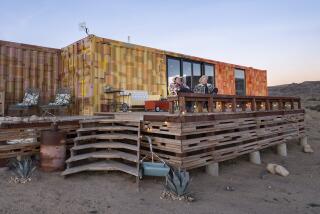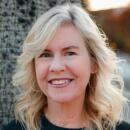Finding a geography of home in the Inland Empire
The first time I saw the images of “In the Sunshine of Neglect” — an exhibition in Riverside by curator Douglas McCulloh on the vast territory of landscapes in my beloved native county — a beautiful confluence of memory, history, image and dreams came pooling into the space. I knew every location in these photographs: the Pomona garages of photographer Tony Maher, the Ontario living rooms of Sally Egan and Amy Bystedt, the Colton hills of Lewis deSoto and the Fontana furnaces of Kaiser Steel.
Together, Riverside and San Bernardino counties encompass more than 27,000 square miles. To grow up in a place that large, bigger than 10 states, is to have seen vistas — along with fires, floods and faults — that others might not have experienced. There could be no better person than McCulloh, who lives in Riverside to put together this immense and yet intimate tour of our home. He’s spent decades taking photographs all over this empire of sunshine that has often been neglected as an American geography as vivid and singular as any other.
To grow up in a place that large, bigger than 10 states, is to have seen vistas ... that others might not have experienced.
For the last 10 years, McCulloh and I collaborated on many stories for KCET and The Times, and four museum shows of our own. We drove everywhere, hearing stories and gathering images, sometimes laughing at a stranger’s tale and sometimes waiting until we got back into my car to sit shaken and silent at someone’s heartache.
“In the Sunshine of Neglect” opens Jan. 19 at the Riverside Art Museum and the California Museum of Photography, and the show is massive, with 194 images spanning seven decades. I immersed myself in the photos to write an essay for the catalog, published by Inlandia Press. Many of the landscapes have literary references for me — scenes in books I love, and surprisingly, two images that reveal something about my grandmother, a major force in my new book. But I drove to these places again and again, marveling at the specificities of place.
Of course, Californians are often chided for believing that to drive is to see and to love a place. We drive a lot. But we also get out and walk or wait. We might stand for hours, watching a hawk, witnessing a fire, seeing boulders collected in a flood. We might laugh or fight with someone on the side of a remote road in the foothills.
To begin this tour of our home county, DeSoto’s images are the perfect way to start. His work “Tahualtapa, Hill of the Ravens (1983–1988),” showing the Colton rail yards and Slover Mountain, takes the viewer through the history of a place that seems to belong to commerce, when really, it is sacred. This was the Hill of Ravens to the Cahuilla peoples here long before anyone else. The Californio settlers then gave it the name Cerro Solo. After that, Isaac Slover, a Kentuckian, killed a bear there; his name was given to a mountain injured by marble quarrying for headstones and virtually destroyed by limestone mining. Author Alex Espinoza’s “Still Water Saints,” set in Agua Mansa, evokes this landscape perfectly, the winding river and broken hills, the desperate descendants of the mountain DeSoto restores to life.
Maher’s photos of his childhood houses replicated as models — his history re-created with tender care — take me back to my own street: the garage of every tract home I saw from my own bedroom window. I remembered the first time I read Joan Didion’s essay “Some Dreamers of the Golden Dream,” set on Vermilion Avenue in the then-new housing tracts of Ontario. It nearly made me cry to learn that he upgraded the color of his miniature replica of his father’s car to red, the vehicle that drove away in his photo “The Day Dad Moved Out,” 1986. My own father, who also left, drove a Mustang.
In their stunning series “Fotomat,” Egan & Bystedt — who met at Chaffey College in Rancho Cucamonga — take many of us back to our youth and the drive-through photo kiosks, those little castles where our lives were handed back to us in envelopes as slides. My stepdad would show these on our wall — click, rasp, click, rasp, click. Or we remember them as square photos we tucked into weirdly elaborate paper corners on the pages of albums. In their series, Egan & Bystedt photograph one another and their children, replicating the 1970s with a precision remarkable for its detail. These were our true lives, in those decades of Pomona and Ontario subdivisions, California sharp-edged light and orange and green and the geometry of mantel and driveway, the way Didion wrote it.
I was shaken by Will Connell’s series on Kaiser Steel, images the Los Angeles photographer took in the 1950s of Kaiser’s Fontana foundries. The photos captured the immense scale of furnace superstructure in the lovely, terrifying light — molten steel being poured into forms to make slab steel to be rolled and sold all over the world — the men watching, working, so close to that light. During those years, my grandmother Rosa Leu, an immigrant from Switzerland, was nurse-in-charge for Kaiser Steel, the woman to whom the injured were brought, located in the small, original hospital on the grounds. I had just written about her impassive demeanor for my memoir, and I finally saw the scale of what she must have done for 30 years, caring for the bodies of these men. I had recently re-read the late U.S. poet laureate Philip Levine’s poem “Orange” and thought of my grandmother, who staunched blood and grew oranges in the promised land of Fontana.
I loved Yolanda Andrade’s personal landscapes of home in Riverside, the places I recognized immediately from my youth, the porches and gardens like shrines, testament to family and fidelity, as in my favorite short stories by Helena Maria Viramontes in her collection “Moth.”
I loved Thomas McGovern’s “People in Cars” (2008-12), taken at the Route 66 Rendezvous in San Bernardino — the parade of classic cars restored and worshiped by so many of my friends — the way we know a 1964 Impala cherried out, the way that historic highway still belongs to us, who live in this Inland Empire, driving slow and raising a chin to acknowledge the things we do that parts of America may never understand. We polish the hood and chrome the engine. We play Art Laboe on the speakers, the hooting of Tony Allen’s “Nite Owl,” and we cruise, just as people cruise in stories by El Monte native Michael-Jaime Becerra and author Héctor Tobar.
If you are stuck in slow traffic as you drive through our region at night, you can see part of a movie at the Rubidoux Drive-In, shown in Julius Shulman’s “Rubidoux Drive-In” just as I remember it, a precisely landscaped dream of Saturday night, where the cars faced the screen like dutiful ships docked at each speaker. I was the oldest of five, and we were free to wander the aisles between the chrome-bumpered cars. My future husband and I saw “Carrie” there. Now, he loads lawn chairs into his truck bed for movies with our adult daughters during their visits. We are the people who not only see movies there but also go to the swap meet on Sundays for the essentials in life, sold in the big parking lot, laid out on tables and truck beds and under tents: clothes and tacos and pots and pans and car parts and tools.
People ask us: “What’s even out there, where you live?”
We say: Everything in the world.
Susan Straight’s memoir, “In the Country of Women,” will be published in August.
More to Read
Sign up for our Book Club newsletter
Get the latest news, events and more from the Los Angeles Times Book Club, and help us get L.A. reading and talking.
You may occasionally receive promotional content from the Los Angeles Times.







